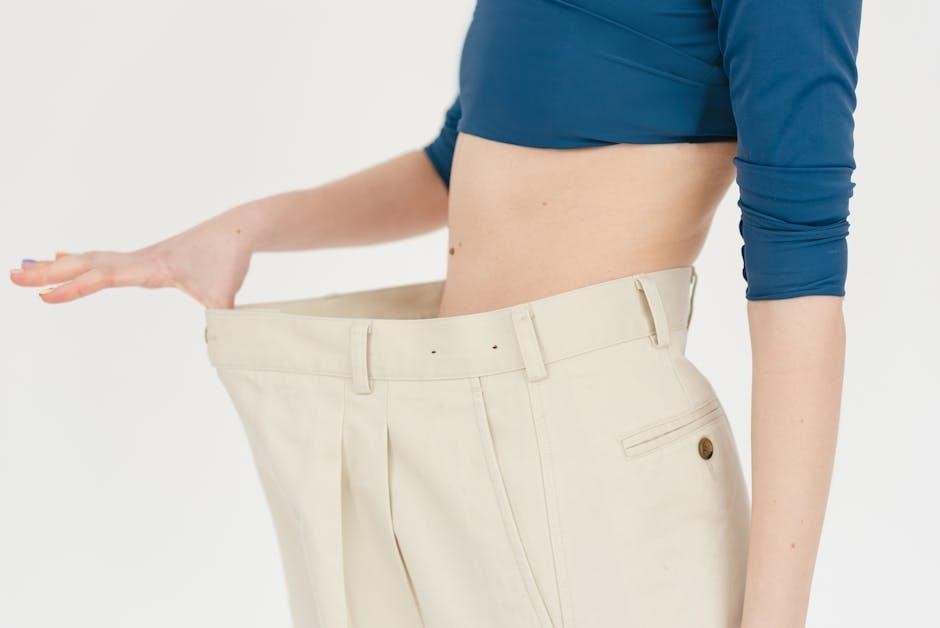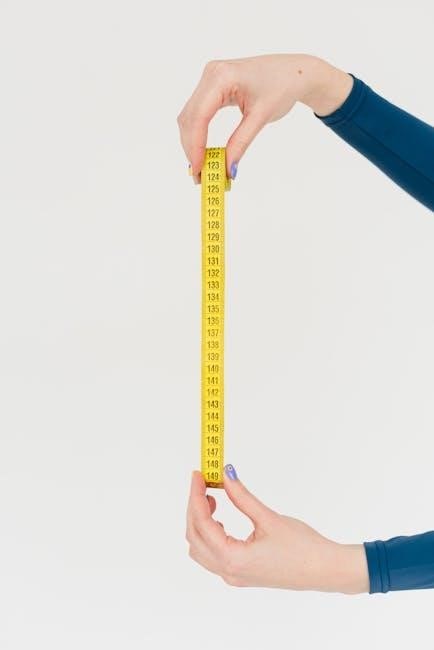Choosing the right bat size is crucial for optimal performance‚ comfort‚ and confidence. This guide helps players of all levels find their ideal bat length and weight‚ ensuring a perfect fit.
1.1 Importance of Choosing the Right Bat Size
Choosing the right bat size is crucial for optimal performance and safety in baseball or softball. A bat that is too long or too heavy can hinder swing mechanics‚ reducing power and control. Conversely‚ a bat that is too short or too light may not generate enough momentum for effective hits. Proper sizing ensures a balanced swing‚ allowing players to maximize their strength and technique. It also reduces the risk of injury‚ as an improperly sized bat can lead to fatigue or poor form. For young players‚ using the right bat size helps develop proper swing habits and builds confidence. Ultimately‚ the correct bat size enables players to perform at their best‚ making it a foundational aspect of the game.

1.2 Overview of the Guide
This guide provides a comprehensive approach to selecting the ideal bat size for players of all ages and skill levels. It covers key factors influencing bat size‚ such as height‚ weight‚ and strength‚ while addressing differences between baseball and softball. The guide includes detailed measurement techniques‚ size charts‚ and league-specific requirements to ensure compliance and optimal performance. Players and parents will find practical advice on avoiding common mistakes and understanding advanced concepts like drop weight. Whether you’re a beginner or an experienced player‚ this guide offers a clear roadmap to finding the perfect bat‚ ensuring comfort‚ safety‚ and success on the field. Its straightforward approach makes bat selection easier and more accurate for everyone.

Understanding Bat Sizing
Bat sizing is crucial for optimal performance and safety‚ as it ensures proper swing mechanics and control. Understanding how size‚ weight‚ and length interact helps players perform better.
2.1 What Determines Bat Size?
Bat size is determined by a combination of factors‚ including the player’s height‚ weight‚ age‚ and strength. These elements help ensure the bat is balanced and manageable. Height and weight provide a baseline for appropriate length and weight‚ while age and strength refine the selection. Younger players require lighter‚ shorter bats‚ while stronger‚ taller players can handle longer‚ heavier options. Additionally‚ the sport type and league specifications influence size requirements. Proper sizing ensures optimal performance‚ comfort‚ and safety‚ making it essential to consider individual characteristics when choosing a bat. This personalized approach helps players maintain control and generate power effectively during their swing. Correct sizing enhances the overall batting experience.
2.2 Key Components of Bat Size
Bat size is primarily determined by three key components: length‚ weight‚ and barrel diameter. The length of the bat affects a player’s reach and control‚ while the weight influences swing speed and power. Barrel diameter impacts the “sweet spot” size‚ affecting how forgiveness the bat is on off-center hits. Longer bats often weigh more‚ but leagues may restrict maximum lengths and weights. Proper balance between these components ensures optimal performance. Players must consider personal strength‚ swing mechanics‚ and game requirements when evaluating these elements. Correct sizing enhances both comfort and effectiveness‚ making it crucial to align these components with individual needs. Understanding these factors helps players select a bat tailored to their abilities. Proper fitting ensures better performance.

Factors Influencing Bat Size
Bat size is influenced by factors such as age‚ strength‚ sport type‚ and league rules. Personal swing mechanics and drop weight also play significant roles.
3.1 Player’s Height
A player’s height is a critical factor in determining bat size‚ as it directly affects the bat’s length and reach. Taller players typically require longer bats to cover the strike zone effectively‚ while shorter players benefit from shorter bats for better control. Generally‚ height correlates with bat length‚ ensuring the player can swing comfortably without compromising performance. However‚ personal comfort and swing mechanics should also be considered‚ as height alone doesn’t always dictate the perfect fit. For example‚ a taller player with a shorter stride might prefer a slightly shorter bat for improved maneuverability. Height guidelines are a starting point‚ but individual preferences and positional needs often influence the final choice. Always test different lengths to find the ideal fit.
3.2 Player’s Weight
A player’s weight plays a significant role in selecting the appropriate bat size‚ as it influences both bat length and weight. Heavier players often prefer slightly longer and heavier bats to generate more power‚ while lighter players may opt for shorter‚ lighter bats for faster swing speeds. Weight affects the bat’s drop weight‚ which is the difference between the bat’s length and its weight; For example‚ a heavier player might prefer a lower drop weight for added mass‚ whereas a lighter player may benefit from a higher drop weight for better bat control. Weight guidelines help narrow down options‚ but personal comfort and swing mechanics should also be considered. Always balance weight with other factors like height and strength for the best fit.
3.3 Age and Strength
Age and strength are critical factors in determining the right bat size‚ as they directly impact a player’s ability to handle the bat effectively. Younger players‚ especially in youth leagues‚ typically require lighter and shorter bats to ensure proper swing mechanics and control; As players grow older and gain strength‚ they can transition to longer and heavier bats‚ which generate more power. Strength also plays a role in bat weight selection‚ as stronger players can manage heavier bats with better swing efficiency. Age-related guidelines often align with strength levels‚ helping players choose bats that match their physical development. Balancing age and strength ensures optimal performance and comfort at the plate‚ while also adhering to league-specific regulations. Always consider these factors alongside height and weight for the best fit.
3.4 Sport Type (Baseball vs. Softball)
The type of sport‚ whether baseball or softball‚ significantly influences bat size and design. Baseball bats are typically shorter and lighter‚ with a smaller barrel diameter‚ as they are designed to hit smaller‚ harder baseballs. In contrast‚ softball bats are longer and heavier‚ with a larger barrel to accommodate the bigger‚ softer ball. These differences ensure optimal performance for each sport. Additionally‚ softball bats often have a higher drop weight due to the larger ball requiring more mass to generate power. Understanding these distinctions helps players choose the right bat for their specific needs. Always consider the sport type when selecting a bat to maximize performance and compliance with game rules.
3.5 League Requirements
League requirements play a crucial role in determining the appropriate bat size for players. Different leagues‚ such as Little League‚ Babe Ruth‚ or high school associations‚ often have specific rules regarding bat length‚ weight‚ and certification. For instance‚ BBCOR (Bat-Ball Coefficient of Restitution) certification is mandatory for high school and college baseball‚ while USA Baseball certification is required for youth leagues. Similarly‚ softball leagues may enforce ASA (Amateur Softball Association) or USSSA (United States Specialty Sports Association) standards. Failing to comply with these regulations can result in disqualification or inability to play. Always check the official league guidelines to ensure the bat meets all necessary standards. Proper certification ensures safety‚ fairness‚ and adherence to the rules of the game.
3.6 Drop Weight
Drop weight‚ a critical factor in bat selection‚ refers to the difference between a bat’s length and its weight. It is expressed as a negative number‚ such as -10 or -12‚ indicating the bat is 10 or 12 ounces lighter than its length in inches. A higher drop weight (e.g.‚ -12) means a lighter bat‚ ideal for younger players or those with less strength‚ as it improves swing speed. Conversely‚ a lower drop weight (e.g.‚ -8) results in a heavier bat‚ often preferred by stronger‚ more experienced players for increased power. Choosing the right drop weight balances swing mechanics and hitting performance. Always consider the player’s strength and skill level when selecting a bat’s drop weight to optimize comfort and effectiveness. Proper drop weight ensures better control and maximizes potential at the plate.
3.7 Skill Level and Swing Mechanics
A player’s skill level and swing mechanics significantly influence bat size selection. Advanced players with stronger swings often prefer heavier bats to generate more power‚ while less experienced players benefit from lighter bats for better control. Swing mechanics‚ such as bat speed and technique‚ also play a role. Players with faster swing speeds may opt for slightly longer bats to cover more of the strike zone‚ while shorter bats suit those with slower swings. Proper bat fit ensures optimal performance and reduces fatigue. It’s crucial to align the bat’s weight and length with the player’s abilities to maximize efficiency and comfort. Consulting a coach or experienced player can help determine the best fit based on individual swing characteristics.

How to Measure for the Right Bat Size
Stand the bat upright‚ measure from the floor to your hip or waist. Hold the bat with both hands to assess weight and comfort.
4.1 Measuring Bat Length
To measure bat length accurately‚ stand the bat upright and measure from the knob to the end of the barrel. For youth players‚ bat length typically ranges from 24 to 32 inches‚ while adult bats are generally between 32 and 34 inches. A common method is to stand the bat beside the player and measure from the ground to their hip or waist. This provides a baseline‚ though adjustments may be needed based on personal comfort and swing mechanics. Proper bat length ensures optimal control and power. Always consider the player’s height and league requirements when selecting a bat length. If unsure‚ try different lengths to find the most comfortable fit; The knob should reach the player’s hip for a balanced swing.
4.2 Determining Bat Weight

Determining the right bat weight involves considering the player’s strength‚ swing mechanics‚ and personal preference. Bat weight is typically measured in ounces‚ with options ranging from 22oz to 32oz for youth bats and up to 34oz for adult bats. A heavier bat can generate more power but may sacrifice swing speed‚ while a lighter bat improves bat control and bat speed. To find the ideal weight‚ players should swing bats of varying weights and choose the one that feels most comfortable. Coaches or experienced players can also provide guidance. Proper bat weight ensures optimal performance and reduces the risk of fatigue during games. Always prioritize comfort and control when selecting bat weight.

Bat Size Charts and Recommendations
This section provides detailed charts and guidelines for selecting the optimal bat size based on player height‚ weight‚ and age. It includes recommendations for both baseball and softball‚ highlighting differences in length and weight ranges. Additionally‚ it compares youth and adult bat sizes‚ ensuring a proper fit for all skill levels. Manufacturers’ size charts are also referenced for accurate measurements.
5.1 Baseball Bat Size Chart
A baseball bat size chart helps players choose the right bat based on their height and weight. Generally‚ players between 3’5″ and 4’5″ tall use bats ranging from 24 to 26 inches. Those between 4’6″ and 5’0″ typically use 26 to 28-inch bats‚ while taller players (5’1″ and above) often prefer 28 to 32-inch bats. Weight also plays a role‚ with lighter players opting for shorter‚ lighter bats. The chart serves as a guide‚ but personal comfort and swing mechanics should also be considered. Always check league-specific requirements‚ as some may have restrictions on bat sizes. This chart is particularly useful for youth players‚ helping them transition to larger bats as they grow.
5.2 Softball Bat Size Chart
A softball bat size chart helps players choose the right bat based on their age‚ height‚ and weight. For youth players‚ bats typically range from 26 to 28 inches in length‚ while adult players often use bats between 28 and 34 inches. Weight is also a factor‚ with lighter bats (e.g.‚ -12 drop weight) suitable for younger players and heavier options (e.g.‚ -8 drop weight) for older‚ stronger athletes.
- Players under 12 years old: 26-28 inches‚ -12 to -10 drop weight.
- Teenagers (13-18 years): 28-30 inches‚ -10 to -8 drop weight.
- Adults: 30-34 inches‚ -8 to -6 drop weight.
Always check league requirements‚ as some may restrict certain lengths or weights. Proper sizing ensures better performance and comfort.
5.3 Youth vs. Adult Bat Sizes
Youth bats are designed for younger players‚ typically under 14 years old‚ and are lighter and shorter in length. They usually range from 24 to 32 inches‚ with smaller barrel diameters to accommodate smaller hands and developing strength. Adult bats‚ on the other hand‚ are longer and heavier‚ often between 32 and 34 inches‚ with larger barrels for more power. Youth bats also tend to have a higher drop weight‚ making them easier to swing for younger players. League rules often dictate specific size requirements for each age group. Choosing the right size ensures better performance‚ control‚ and comfort for players of all ages and skill levels.

League-Specific Bat Requirements
League-specific bat requirements ensure compliance with performance and safety standards. Each league sets rules for length‚ weight‚ drop weight‚ and material. Always verify specifications before purchase.
6.1 BBCOR Bats
BBCOR (Bat-Ball Coefficient of Restitution) bats are certified for use in college and high school baseball. This standard measures the bat’s performance by determining how much energy is lost during contact with the ball. BBCOR bats must have a coefficient of 0.5 or lower‚ ensuring a safer and more balanced game. These bats are designed for advanced players and are required in NCAA and NFHS leagues. They typically feature a -3 drop weight and are available in lengths ranging from 31 to 34 inches. Choosing a BBCOR bat ensures compliance with league regulations and optimizes performance for older‚ more experienced players.
6.2 USSSA Bats
USSSA (United States Specialty Sports Association) bats are widely used in youth baseball and softball leagues. These bats are known for their high performance and durability‚ catering to players who require a balance between power and control. USSSA bats typically feature a larger barrel diameter compared to BBCOR bats‚ often ranging from 2 5/8″ to 2 3/4″. They are designed to meet specific performance standards‚ ensuring optimal pop and distance on contact. The length-to-weight ratio‚ or drop weight‚ for USSSA bats usually ranges from -5 to -12‚ making them suitable for a variety of players. USSSA certification is mandatory for participation in many youth leagues‚ ensuring compliance with safety and performance regulations. Players often prefer USSSA bats for their responsiveness and Forgiving swing mechanics.
6.3 USA Bats
USA Bats are designed for youth players and adhere to the certification standards set by USA Baseball. These bats are engineered to deliver balanced performance‚ combining power and control. They are ideal for younger players transitioning to higher levels of competition. USA Bats typically feature a lower drop weight range‚ making them suitable for developing strength and swing mechanics. The certification ensures compliance with safety and performance regulations‚ making them a popular choice for leagues requiring USA Bat standards. When selecting a USA Bat‚ consider the player’s height‚ weight‚ and strength to find the optimal size. Proper sizing ensures better swing efficiency and overall performance. Always verify the bat’s certification before purchase to meet league requirements.
6.4 Fastpitch Softball Bats
Fastpitch softball bats are designed for the unique demands of the game‚ with a focus on speed‚ control‚ and performance. These bats are typically certified by organizations like ASA (Amateur Softball Association) or USSSA (United States Specialty Sports Association). Players aged 14 and under often use bats with a smaller barrel diameter‚ while older players may opt for larger barrels. Lengths range from 28 to 34 inches‚ with weights varying based on the player’s strength and swing mechanics. Fastpitch bats often feature lightweight composite materials for faster swing speeds. When choosing a bat‚ consider the player’s height‚ strength‚ and hitting style to ensure optimal performance and comfort. Proper certification and sizing are crucial for both safety and compliance.

Avoiding Common Mistakes in Bat Selection
Avoiding common mistakes in bat selection is crucial for optimal performance. Key pitfalls include ignoring drop weight‚ not considering league rules‚ and overlooking personal comfort during the process.
- Ensure proper measurements and certifications for your league.
- Balance bat length‚ weight‚ and swing mechanics effectively.
7.1 Ignoring Drop Weight
One of the most critical mistakes in bat selection is ignoring the concept of drop weight. Drop weight‚ expressed as a negative number‚ is the difference between the bat’s length (in inches) and its weight (in ounces). For example‚ a 32-inch bat that weighs 22 ounces has a drop weight of -10. Ignoring this factor can lead to using a bat that is either too heavy or too light‚ affecting performance and comfort. A bat with the wrong drop weight can slow down swing speed or reduce power‚ making it harder to hit effectively. Always consider drop weight based on the player’s strength‚ skill level‚ and league requirements to ensure optimal performance and comfort.
7.2 Not Considering League Rules
One of the most common mistakes in bat selection is failing to consider league-specific rules and regulations. Different leagues‚ such as USSSA‚ USA Baseball‚ and BBCOR‚ have distinct requirements for bat performance‚ certification‚ and design. Ignoring these rules can result in the bat being deemed illegal for play‚ leading to disqualification or inability to participate. Always verify the certification stamps and standards required by your league before purchasing or using a bat. Additionally‚ some leagues have restrictions on barrel size‚ length-to-weight ratio‚ and material types. Checking these guidelines ensures compliance and avoids potential issues during games or tournaments.
7.3 Overlooking Personal Comfort
Personal comfort is a critical yet often overlooked factor in bat selection. A bat that feels right in your hands can significantly improve your performance and control; While size charts provide a general guide‚ they don’t account for individual preferences in grip‚ feel‚ and balance. Players should consider the knob’s shape‚ handle thickness‚ and overall weight distribution. Testing different bats during practice or in a store can help identify the most comfortable option. Ignoring comfort may lead to fatigue‚ poor swing mechanics‚ or even injuries. Always prioritize how the bat feels‚ as confidence and ease at the plate are just as important as technical specifications. A well-fitting bat enhances both enjoyment and success in the game.

Special Considerations
When selecting a bat‚ there are additional factors to consider beyond size and league requirements. Material preferences‚ such as aluminum‚ composite‚ or wood‚ can impact performance and durability. Weather conditions and temperature may also affect bat performance‚ particularly for composite bats‚ which can become less responsive in cold climates. Additionally‚ the intended use of the bat—whether for practice‚ games‚ or specific positions—can influence the choice. Personal comfort‚ including grip size and knob style‚ should not be overlooked. Lastly‚ maintaining the bat properly‚ such as avoiding excessive heat or improper storage‚ ensures optimal longevity and performance. These considerations ensure the bat not only fits but also enhances the player’s overall experience.
- Material type affects durability and performance.
- Weather and temperature can impact bat responsiveness.
- Intended use influences bat selection.
- Personal fit extends beyond size to grip and feel.
- Proper maintenance prolongs bat life.
